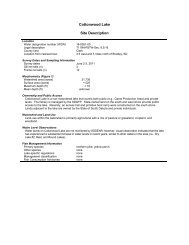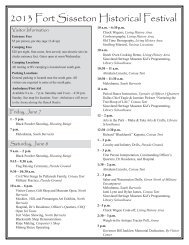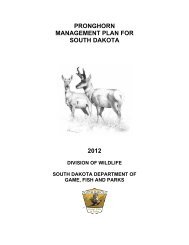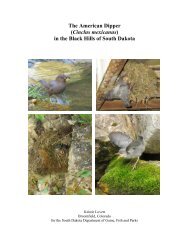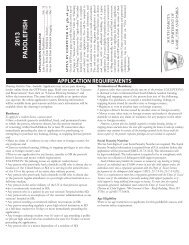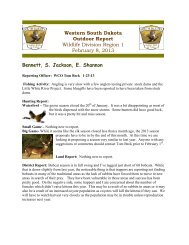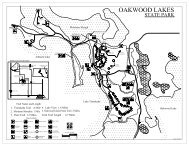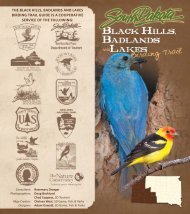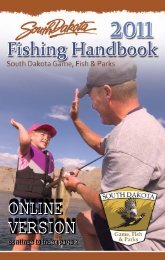pdf version - South Dakota Department of Game, Fish and Parks
pdf version - South Dakota Department of Game, Fish and Parks
pdf version - South Dakota Department of Game, Fish and Parks
Create successful ePaper yourself
Turn your PDF publications into a flip-book with our unique Google optimized e-Paper software.
PERCH (family Percidae)<br />
Johnny Darter<br />
Etheostoma nigrum<br />
Quick key characteristics: The johnny darter is found in cool- to warmwater<br />
habitats. Its scales are moderate in size <strong>and</strong> readily visible. It has two,<br />
separated <strong>and</strong> elongated dorsal fi ns, one (in front) with sharp spines instead<br />
<strong>of</strong> rays <strong>and</strong> one spine in the anal fi n. It has a small, downward-facing mouth,<br />
overhung by a blunt, rounded snout. Its body is tubular.<br />
Similar species in <strong>South</strong> <strong>Dakota</strong>: other darters<br />
Identifi cation: A protrusible, downward-facing mouth, dark “w,” “j,” <strong>and</strong> “s”<br />
-shaped markings along lateral line, <strong>and</strong> lack <strong>of</strong> bright breeding coloration<br />
distinguish the johnny darter from similar fi shes in <strong>South</strong> <strong>Dakota</strong>.<br />
Range: The johnny darter is native to east-central North America. In <strong>South</strong><br />
<strong>Dakota</strong>, it is native to river basins south <strong>and</strong> east <strong>of</strong> the Missouri River –<br />
White River confl uence, but it appears to be either introduced or naturally<br />
extending its range upstream among Missouri River impoundments <strong>and</strong><br />
western tributaries, in part due to its tolerance <strong>of</strong> turbidity <strong>and</strong> ability to<br />
occupy a variety <strong>of</strong> habitat types.<br />
Items <strong>of</strong> interest:<br />
• Feeds on insects <strong>and</strong> crustaceans<br />
• Males defend spawning territories with overhanging rocks or other<br />
structures<br />
• Eggs are laid <strong>and</strong> fertilized on the<br />
underside <strong>of</strong> an overhang while<br />
females <strong>and</strong> males are upside-down<br />
• Can reach 3 in<br />
59






